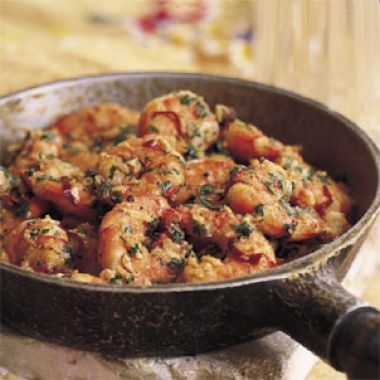
A cook's greatest creativity is often most evident in the small dishes that begin a meal, and the cooks of Spain and Portugal are no exception. In Portugal these opening plates are called acepipes, while in Spain, where they have been elevated to an art form, they are known as tapas.
The word tapa comes from tapar, to cover, and it originated with a barkeep's habit of placing a little plate or slice of bread on top of a glass of wine to keep out flies. Soon a tidbit of food was set on the plate—a slice of ham, a piece of cheese—and thus an enduring tradition was born. Today, el tapeo, the custom of traveling from bar to bar and sampling just a dish or two—the bar's specialties—at each one, is a popular ritual, especially in picturesque Andalusia, the home of the tapa. In Seville, the acknowledged capital of these small plates, wise visitors thread their way through the narrow, untouristed streets of La Macarena, pausing to admire a fifteenth-century palace that once housed the Dukes of Alba, stopping to buy marmalade from nuns at the Convento de Santa Paula, and then perhaps beginning their tapeo at the tile-faced El Rinconcillo, the oldest bar in the city.
This elaborate "course" grew out of the dining habits of Spaniards—habits that differ from those of the neighboring Portuguese. In Portugal, for example, breakfast is at about eight o'clock, followed by lunch, or almoço, which begins around twelve-thirty, and finally dinner at eight or so. The Spanish routine is more complicated. Breakfast is taken twice, with café con leche and a roll consumed quite early and the heartier almuerzo, perhaps a bocadillo (small sandwich), eaten around eleven. Lunch, or the comida, begins at two, followed by a siesta, and then at about six o'clock a snack, the merienda, which is usually a pastry or sandwich and coffee or tea. Between seven or eight and ten o'clock in Seville, Madrid, Barcelona, and elsewhere, the tapas bars are filled. Then it is time for dinner, la cena, at ten or even later.
Tapas fall into three major categories: cosas de picar, pinchos, and cazuelas. Cosas de picar, the biggest group, are essentially finger foods—a bowl of marinated olives or fried almonds, a wedge of cheese, slices of sausage. Montaditos, spreads on bread; empanadillas, foods encased in a crust; tartaletas, tiny filled pastry shells; bocadillos; slices of tortilla; and deviled eggs all fall under this banner, as do fritos (fried foods) and buñuelitos (small fritters), both of which are usually served with alioli.
Pinchos, including banderillas (named for the dart thrust into the bull at a bullfight) and palillos, are skewered foods, whether on toothpicks or larger rods. Cazuelas or cazuelitas, dishes cooked in earthenware pots of the same names, require utensils for eating. All three types are usually accompanied with sherry or another wine, or with cider in Asturias.
Acepipes have never achieved the culinary extravagance or the social importance that tapas enjoy in Spain. The Portuguese customarily consume their small plates in a local bar, which, even in Lisbon or Oporto, is often no more than a small room with a wooden counter and barrels from which rough red wine is released into narrow tumblers. Small dishes holding olives, almonds, bolinhos de bacalhau, or perhaps slices of ham or cheese, may be lined up on the bar top.
Adapted from Williams-Sonoma Savoring Series: Savoring Spain & Portugal, Joyce Goldstein (Time-Life Books, 2000)
Related Recipes:
- Sizzling Shrimp with Garlic (Gambas al Pil Pil) →
- Eggplant Salad with Onions and Peppers (Escalivada) →
- Patatas Bravas with Tomato Aioli →
- Peppers Stuffed with Salt Cod (Pimientos Rellenos de Bacalao) →
- Moorish Pork Kabobs (Pinchos Morunos) →
- Spanish Tortilla with Chorizo →
- Cremini Mushrooms Stuffed with Spanish Ham →
- Green Olive and Manchego Puffs →
- Roasted Shrimp with Romesco →
- Blistered Padrón Peppers →













